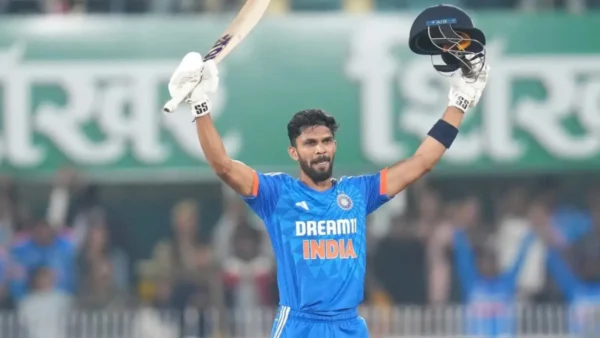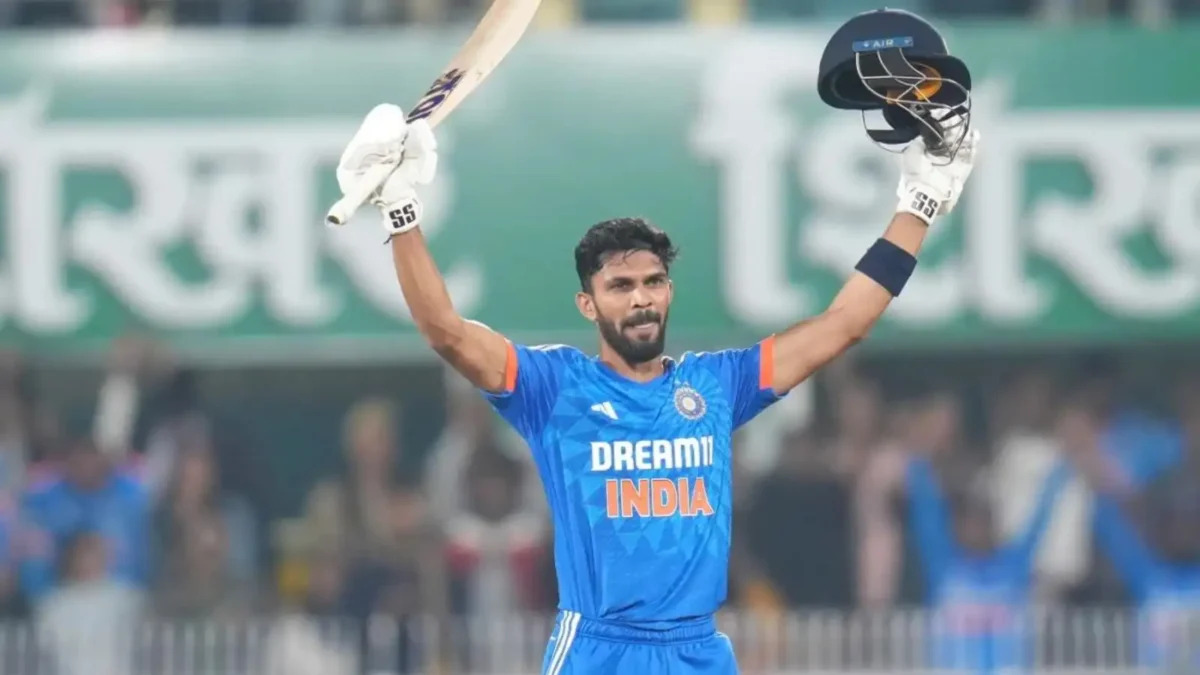
Ruturaj Gaikwad has been focusing on consistency, even if it comes at the expense of scoring rate.

It’s hard being an Indian opener in T20Is at the moment. There are plenty in the queue, and the ones playing have to pile on runs regularly in a format prioritising impact over consistency. That’s where the problem lies.
Ruturaj Gaikwad has been focusing on consistency, even if it comes at the expense of scoring rate. He has all the shots in his armour but only unleashes them after settling in. Is there room for such batting in T20Is now?
When Gaikwad notched up a ton against Australia in Guwahati, he was 22 off 22 balls while Suryakumar Yadav was hitting them well. Understandable, the track wasn’t easy to bat early on, but he still needed to take calculative risk. Fortunately, Gaikwad accelerated amazingly later and scored 101 runs in 35 balls.
That’s an acceleration of the highest order. Gaikwad is indeed among the most consistent boundary hitters once settling in, but what if it doesn’t come off? It’s not that the batters have to become blind sloggers; that’s not T20, but there has to be an ideal tempo in the innings.
It’s also worth noting that the tracks won’t get as flat to bat as they got in Guwahati, and neither will the dew settle in so early. Not to mention, the Australian attack was far from formidable. It hardly had anyone from the ones we will see in the West Indies and USA next year.
A perfect example of the downsides of such knocks was on display in Raipur a couple of nights later. The surface was slow, and the strokes weren’t as easy-coming as they were in three games earlier in the series. Ruturaj Gaikwad, as always, was slow off the blocks, reeling on 22 runs in 23 balls and getting out while attempting to break the shackles.
It was the 13th over of the innings, and Gaikwad left India nowhere with his dismissal. The score was 111/4. Mind you, spin is Gaikwad’s stronger suit; he plays it quite well.
It wasn’t Gaikwad’s fault it didn’t come off; it happens. But he refused to be flexible, and that was his fault. Yashasvi Jaiswal tried to up the ante, and so did Shreyas Iyer, getting out in the process.
On that track, Gaikwad could have gone for more boundaries during the field restrictions and, maybe, when Chris Green and Matthew Short came after the powerplay. He hit only one boundary in the first nine overs and five balls. That’s half of the whole innings.
Also Read: India’s T20I pace attack: An area of concern
In the Asian Games earlier this year, Gaikwad made 25 runs in 23 balls against Nepal in the 1st Quarter-Final, while his partner, Yashasvi Jaiswal, amassed a ton. He couldn’t accelerate despite short boundaries and a weak bowling attack. Such knocks underline the importance of not going into the shell, for it’s impossible to cover most often later on.
This year, Gaikwad has a middling strike rate of 125.71 in the first ten balls in T20Is, inflated due to his rapid start against Bangladesh in the Asian Games. Even during the 11-20 balls phase, Gaikwad strikes at only 107.57, taking around 9.42 balls for every boundary. Overall, he has a strike rate of 116.91 and a balls-per-boundary ratio of 6.18 in the first 20 balls, which is below par and unacceptable.
Gaikwad doesn’t risk his wicket at all early on, even on the flat tracks, which has mostly been the case in T20Is this year. Only twice has his strike rate been above 135 in seven innings (excluding his diamond duck) despite facing more than 25 balls as many as five times. His two knocks of 58(43) are proper match-losing in this format against the quality teams.
Ruturaj has a mediocre strike rate of 118.75 and takes 5.33 balls for every boundary in the T20Is powerplay this year. He also plays 46.87% of dot balls. The important part is that Gaikwad has lost his wicket only once in eight innings, that too due to an unfortunate run out.
Gaikwad’s most significant strength lies in taking the spinners down after settling in, and it might even be effective if the tracks are slow in the T20 World Cup next year. But the teams are smart enough to cramp him with the pacers, and Ruturaj tries to force himself to cover up for the slow start. It was also visible during his century knock against Australia a few days back when he struggled to get going in the initial phase. Had the Aussie bowlers restricted from bowling filth and dew didn’t come in, Gaikwad would have again ended up playing a tepid knock.
India have adopted a gung-ho approach across the white-ball formats. It’s absolutely necessary to maximise the powerplay, and Rohit displayed it despite playing a 50-over format. Despite losing his wicket numerous times, Jaiswal has not altered his approach.
Even if India require an anchor, Shreyas Iyer (if he plays) and Suryakumar Yadav can do that with better precision. In fact, Suryakumar can play throughout the innings without compromising the scoring rate, as visible plenty of times in the previous two years. Iyer can do a similar role while batting at No.3.
If India want to play a fearless brand of cricket, something they have emphasised a lot, the openers have to go hard early on. India have also moved on from Rohit Sharma and Virat Kohli, at least for now, and accommodated the young ones to be aggressive. If Gaikwad plays with current intent, they can simply bring back one of Rohit Sharma or Virat Kohli.
Rohit’s new template was quite effective in the World Cup 2023, and he would do a better job than Gaikwad. Even if Rohit maximises the first six overs, it will be enough in this format. A team doesn’t win or lose in the powerplay, but the proceedings in this phase definitely define the pace for the rest of the innings.
When Gaikwad bats in T20Is, the comparisons are drawn with Virat Kohli, for they see a similar template in both batters’ way of pacing the innings. That’s a false narrative. Kohli is much better with his T20 game and has been a proven match-winner over the years.
Kohli’s game against the pacers is way better than Gaikwad’s, and it helps him accelerate better. In fact, Kohli starts quicker and hardly puts pressure on his partners, unlike Gaikwad, who refuses to go hard most of the times. When Virat opened for Royal Challengers Bangalore this year, he was massively successful with his tried and tested method.
Gaikwad might be better equipped than Kohli against the spinners, but the latter has shown encouraging signs lately. His superior gameplay against the speedsters means he will always have a better chance of succeeding. Kohli can smash the pacers without losing shape, even on the slow decks, unlike Gaikwad, who tends to overtry things.
Shubman Gill was ahead in the pecking order, but Gaikwad’s consistency would have pressured him. But Gill’s method is also greater than Gaikwad’s, and his technique is more compact. He also has a better pace game and is improving against the slow bowlers.
In this IPL, Gill showed a superior boundary-hitting ability and still weaved big knocks. He had a strike rate of 158.15 and a balls-per-boundary ratio of 4.97 against the spinners. Gill previously struck at 132.06 while taking 7.48 deliveries for every boundary till the last season.
Meanwhile, Gaikwad struck at 162.25 while hitting a boundary every 5.39 balls against spin. Gill averaged 63 in contrast to Gaikwad, who averaged a mere 30.62. It’s not to conclude that Gill handles spin better than Gaikwad, but the numbers show that the former has come a long way.
While Gill might not be playing in T20Is, he should be ahead of Gaikwad and open along with Jaiswal. Ishan Kishan is a similar batter to Gaikwad. But Gaikwad’s ability to thrash the spinners at will makes him a better prospect, while he handles pace well with the new ball.
Kishan struggles severely against the moving ball while he gets stuck against the spinners. He is a massive no in T20Is unless he improves significantly against spin. All other options are better than the current version of Kishan.
So, India have two better options than Gaikwad quality-wise – Shubman Gill and Virat Kohli. Even Rohit can play if he continues a similar approach to the World Cup. For Gaikwad, it might be harsh, but he shouldn’t open.
It’s not that Gaikwad can’t find a place in the XI. He will be superbly suited at No.3, as India can utilise his spin expertise then. Gaikwad might be a better option than Shreyas Iyer because he is a more consistent boundary hitter and doesn’t get stuck as much against the pacers.
If Gaikwad bats one down, India will have two ideal openers – Yashasvi Jaiswal and Shubman Gill – with a skilled spin player at No.3 followed by Suryakumar Yadav.
This lineup covers everything and ensures India extract the most out of the powerplay. A proper powerplay basher, a skilled pace player with an improved spin record, a talented spin player with a developing pace record and a T20 specialist – a dynamic combination for the shortest format. With Jaiswal being an LHB, the batting doesn’t become one-dimensional.
It’s a race between top-tier batters, but India have to be wise with their picks rather than selecting players based on a few innings. Ruturaj Gaikwad can’t open unless the management wants to go ahead with an approach that has haunted them in the past. There are finer options to do Gaikwad’s job at the top as well.
*Stats till IND vs AUS 4th T20I
For more updates, follow CricXtasy on Facebook, Instagram, Twitter, and YouTube.